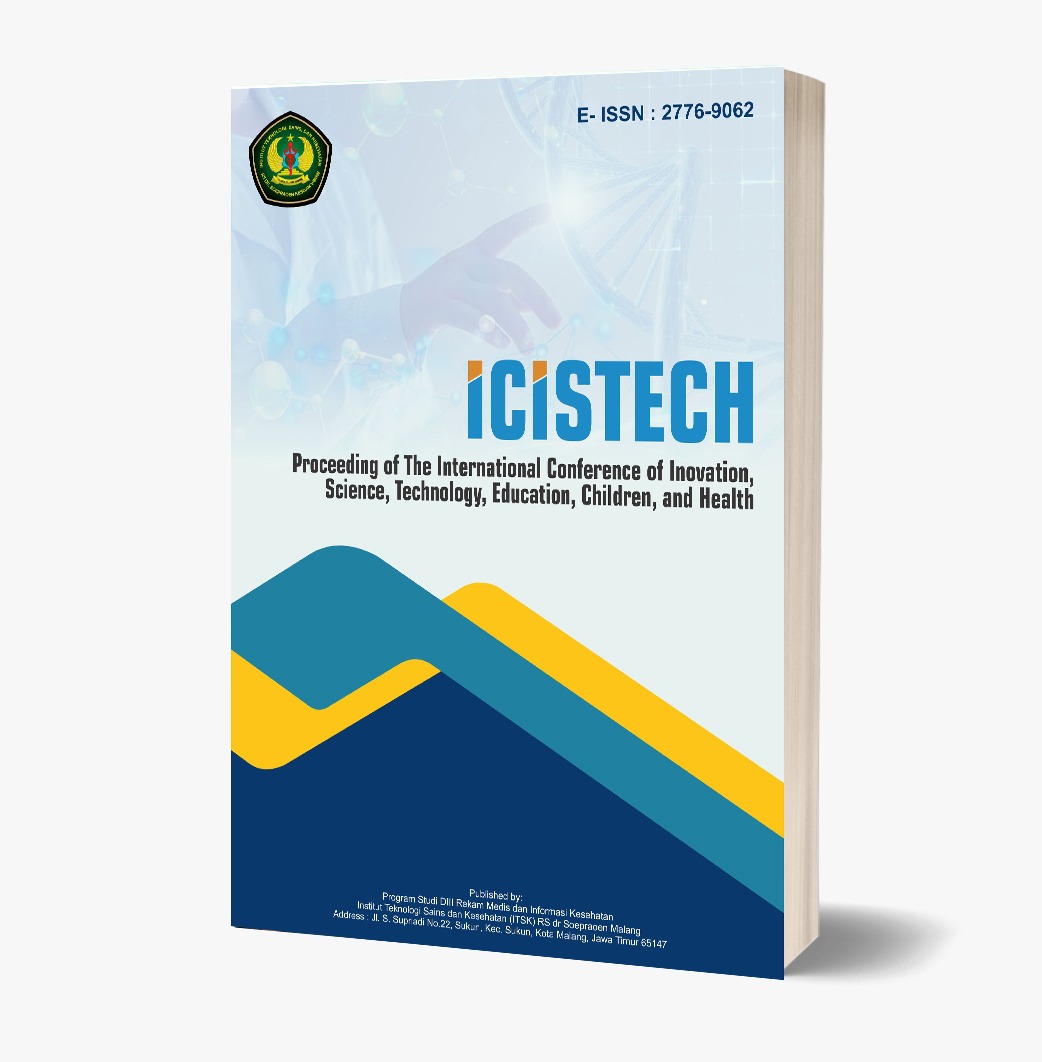Efforts To Increase Understanding Of Pregnant Women Related To Covid-19 Prevention And Distribution Of Mask In Karang Village Temu, Health Center Working Area Of Lingsar District, West Lombok
DOI:
https://doi.org/10.62951/icistech.v2i1.16Keywords:
pregnant, women, prevention, covid-19Abstract
The purpose of this research is to find out the efforts to increase under- satnding of pregnant women related to covid-19 prevention and distribution of masks in Karang village temu, health center working area of lingsar district, west lombok. by using a community-based intervention method carried out in Batu Mekar Village, Lingsar District, West Lombok Regency. Efforts to increase understanding of pregnant women about Covid-19 prevention and distribution of masks through classes for pregnant women In Batu Mekar Village, the working area of the Lingsar Health Center, the results were that pregnant women understood Covid-19 prevention, and understood the benefits and how to use masks.
References
C. R. Titaley et al., “Increasing the uptake of long-acting and permanent methods of family planning: A qualitative study with village midwives in East Java and Nusa Tenggara Barat Provinces, Indonesia,” Midwifery, 2017, doi: 10.1016/j.midw.2017.07.014.
KemenKes_RI, “Situasi Terkini Perkembangan (COVID-19),” Kemenkes, 2021.
J. K. Spittlehouse, P. R. Joyce, E. Vierck, P. J. Schluter, and J. F. Pearson, “Ongoing adverse mental health impact of the earthquake sequence in Christchurch, New Zealand,” Aust. N. Z. J. Psychiatry, 2014, doi: 10.1177/0004867414527522.
P. W. Handayani, A. N. Hidayanto, P. I. Sandhyaduhita, Kasiyah, and D. Ayuningtyas, “Strategic hospital services quality analysis in Indonesia,” Expert Syst. Appl., 2015, doi: 10.1016/j.eswa.2014.11.065.
G. Moroni et al., “Fetal outcome and recommendations of pregnancies in lupus nephritis in the 21st century. A prospective multicenter study,” J. Autoimmun., 2016, doi: 10.1016/j.jaut.2016.07.010.
F. C. Coelho et al., “Higher incidence of Zika in adult women than adult men in Rio de Janeiro suggests a significant contribution of sexual transmission from men to women,” Int. J. Infect. Dis., 2016, doi: 10.1016/j.ijid.2016.08.023.
A. Lewin et al., “Univariate predictors of maternal concentrations of environmental chemicals: The MIREC study,” Int. J. Hyg. Environ. Health, 2017, doi: 10.1016/j.ijheh.2017.01.001.
K. Riskesdas, “Hasil Utama Riset Kesehatan Dasar (RISKESDAS) Tahun 2018,” J. Phys. A Math. Theor., 2018.
L. Chen et al., “Clinical Characteristics of Pregnant Women with Covid-19 in Wuhan, China,” N. Engl. J. Med., 2020, doi: 10.1056/nejmc2009226.
L. Zhang et al., “Analysis of the pregnancy outcomes in pregnant women with COVID-19 in Hubei Province,” Zhonghua Fu Chan Ke Za Zhi, 2020, doi: 10.3760/cma.j.cn112141-20200218-00111.
M. Withers, N. Kharazmi, and E. Lim, “Traditional beliefs and practices in pregnancy, childbirth and postpartum: A review of the evidence from Asian countries,” Midwifery, 2018, doi: 10.1016/j.midw.2017.10.019.
E. T. Konje, M. T. N. Magoma, J. Hatfield, S. Kuhn, R. S. Sauve, and D. M. Dewey, “Missed opportunities in antenatal care for improving the health of pregnant women and newborns in Geita district, Northwest Tanzania,” BMC Pregnancy Childbirth, 2018, doi: 10.1186/s12884-018-2014-8.
N. Nair et al., “Effectiveness of Behaviour Change Communication Interventions in Improving the Delivery of Health Messages for Antenatal Care In Limited Literacy Settings: An Evidence Summary,” London EPPI-Centre, Soc. Sci. Res. Unit, UCL Inst. Educ. Univ. Coll. London., 2017.
C. McParlin, R. Bell, S. C. Robson, C. R. Muirhead, and V. Araújo-Soares, “What helps or hinders midwives to implement physical activity uidelines for obese pregnant women? A questionnaire survey using the Theoretical Domains Framework,” Midwifery, 2017, doi: 10.1016/j.midw.2016.09.015.
F. Rahman, L. Marlinae, R. Setyaningrum, A. O. Putri, and Hilmiyati, “The role of midwife through antenatal class pregnancy for improvement delivery assistance with professional health workers,” Indian J. Public Heal. Res. Dev., 2018, doi: 10.5958/0976-5506.2018.00031.1.
J. P. Meyer, K. Isaacs, O. El-Shahawy, A. K. Burlew, and W. Wechsberg, “Research on women with substance use disorders: Reviewing progress and developing a research and implementation roadmap,” Drug and Alcohol Dependence. 2019, doi: 10.1016/j.drugalcdep.2019.01.017.
R. Hanum and M. E. Safitri, “Hubungan Pengetahuan dan Sikap Ibu Hamil tentang Pemanfaatan Buku KIA di Puskesmas Namu Ukur,” J. Bidan Komunitas, 2018, doi: 10.33085/jbk.v1i3.3968.
D. A. Rina and L. Meliati, “The Implementation of Healthy Food Diet for High-Risk Pregnant Woman (Amaris) Class on The Level of Knowledge and Attitude of Pregnant Woman,” J. Kesehat. Masy., 2020, doi: 10.15294/kemas.v16i2.22579.
Y. P. Rahayu, F. M. Panjaitan, S. Sari, M. Banjarmasin, and P. K. Banjarbaru, “Hubungan Pengetahuan Dan Sikap Ibu Hamil Tentang Tanda Bahaya Kehamilan Terhadap Pemanfaatan Buku Kia Di Upt. Puskesmas Martapura,” Din. Kesehat., 2018.
A. I. Rachmawati, R. D. Puspitasari, and E. Cania, “Faktor-faktor yang Memengaruhi Kunjungan Antenatal Care ( ANC ) Ibu Hamil,” Majority, 2017.
H. Kitabayashi, C. Chiang, A. A. A. Al-Shoaibi, Y. Hirakawa, and A. Aoyama, “Association Between Maternal and Child Health Handbook and Quality of Antenatal Care Services in Palestine,” Matern. Child Health J., 2017, doi: 10.1007/s10995-017-2332-x.
S. A. Rahman, A. Handayani, S. Sumarni, and A. Mallongi, “PENURUNAN NYERI PERSALINAN DENGAN KOMPRES HANGAT DAN MASSAGE EFFLEURAGE,” Media Kesehat. Masy. Indones., 2017, doi: 10.30597/mkmi.v13i2.1986.
S. N. Mbalinda, A. Nakimuli, O. Kakaire, M. O. Osinde, N. Kakande, and D. K. Kaye, “Does knowledge of danger signs of pregnancy predict birth preparedness? A critique of the evidence from women admitted with pregnancy complications,” Heal. Res. Policy Syst., 2014, doi: 10.1186/1478-4505-12-60.
W. Wijayanti, “HUBUNGAN PEMANFAATAN BUKU KIA DENGAN PENGETAHUAN IBU HAMIL TENTANG TANDA BAHAYA KEHAMILAN,” Profesi (Profesional Islam. Media Publ. Penelit., 2017, doi: 10.26576/profesi.153.
K. Campbell, H. Rowe, H. Azzam, and C. A. Lane, “The Management of Nausea and Vomiting of Pregnancy,” J. Obstet. Gynaecol. Canada, 2016, doi: 10.1016/j.jogc.2016.08.009.
L. D. Kumar, R. Karthik, N. Gayathri, and T. Sivasudha, “Advancement in contemporary diagnostic and therapeutic approaches for rheumatoid arthritis,” Biomedicine and Pharmacotherapy. 2016, doi: 10.1016/j.biopha.2016.02.001.
S. E. M. Truijens et al., “The HAPPY study (Holistic Approach to Pregnancy and the first Postpartum Year): Design of a large prospective cohort study,” BMC Pregnancy Childbirth, 2014, doi: 10.1186/1471-2393-14-312.
L. Mazzolai et al., “Diagnosis and management of acute deep vein thrombosis: A joint consensus document from the European Society of Cardiology working groups of aorta and peripheral vascular diseases and pulmonary circulation and right ventricular function,” European Heart Journal. 2018, doi: 10.1093/eurheartj/ehx003.
K. Arcoleo, L. E. Zayas, A. Hawthorne, and R. Begay, “Illness representations and cultural practices play a role in patient-centered care in childhood asthma: Experiences of Mexican mothers,” J. Asthma, 2015, doi: 10.3109/02770903.2014.1001905.
C. T. Beck, “Mother-Infant Interaction During Postpartum Depression: A Metaphor Analysis,” Can. J. Nurs. Res., 2020, doi: 10.1177/0844562119897756.
H. Allahem and S. Sampalli, “Automated uterine contractions pattern detection framework to monitor pregnant women with a high risk of premature labour,” Informatics Med. Unlocked, 2020, doi: 10.1016/j.imu.2020.100404.
A. Barney, S. Buckelew, V. Mesheriakova, and M. Raymond-Flesch, “The COVID-19 Pandemic and Rapid Implementation of Adolescent and Young Adult Telemedicine: Challenges and Opportunities for Innovation,” J. Adolesc. Heal., 2020, doi: 10.1016/j.jadohealth.2020.05.006.
K. Fryer, A. Delgado, T. Foti, C. N. Reid, and J. Marshall, “Implementation of Obstetric Telehealth During COVID19 and Beyond,” Matern. Child Health J., 2020, doi: 10.1007/s10995-020-02967-7.
Downloads
Published
How to Cite
Issue
Section
License
Copyright (c) 2022 Proceeding of The International Conference of Inovation, Science, Technology, Education, Children, and Health

This work is licensed under a Creative Commons Attribution-ShareAlike 4.0 International License.













